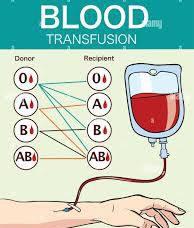
By Adejumo Florence
Medical procedure that involves transferring blood or blood products from a donor into a patient’s bloodstream. Here are some key aspects of blood transfusion:
Purpose of blood transfusion
– To replace blood lost due to surgery, injury, or illness
– To treat medical conditions such as anemia, bleeding disorders, and cancer
– To support organ transplant patients
Blood Types
– ABO blood group system (A, B, AB, O)
– Rh blood type system (Rh positive or negative)
– Compatibility testing to ensure safe transfusion
and reaction
However, blood transfusion actually have some dangers which we have to be careful of;
1. Allergic reactions.
2. Infection transmission.
3. Blood-borne disease transmission.
Safety way to blood transfusion
1. Screening of donors for infectious diseases
2. Testing of donated blood for HIV, HBV, HCV, and other diseases
3. Sterile equipment and techniques used
Blood transfusions are a lifesaving medical intervention, and the risks are minimized by strict screening and testing processes.
How frequently to donate blood
– Whole blood donation: Every 56 days (8 weeks)
– Plasma donation: Every 28 days
– Platelet donation: Every 7 days
